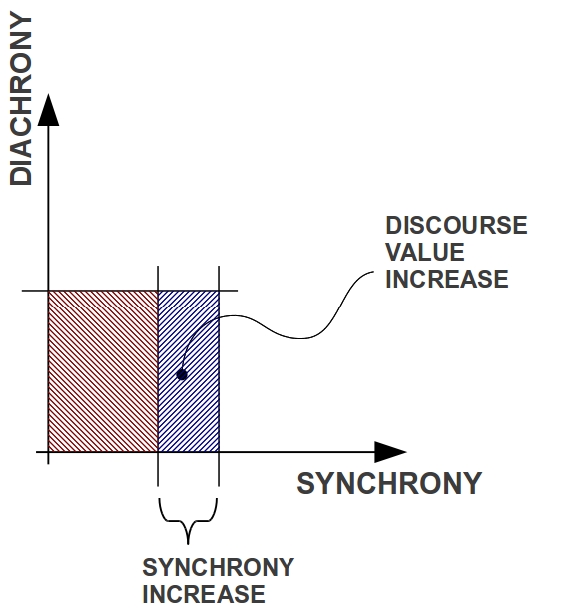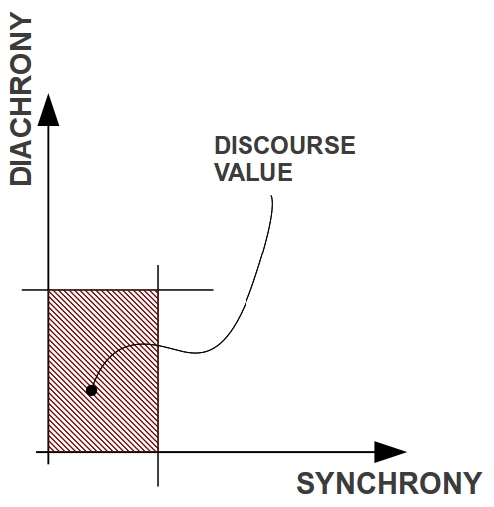Interpretation keys of the project of man in the dimension of time.
INTRODUCTION
CHORDS AND MELODY
NARRATIVE AND METAPHOR
PROJECT POINT OF VIEW
FACING NECESSITY
APPENDIX: SYNCHRONIC DISCOURSES OR DIACHRONIC ONES?
INTRODUCTION
Synchronic and diachronic are two concepts employed by Ferdinand De Saussure[1]to describe the way one studies the nature of languages. The prefix dia means through and chrono is time: a diachronic vision entails objects going through time. The prefix syn implies togetherness, and the objects of a synchronic discourse occur together at the same time. A synchronic vision takes into account the reciprocal positions of the objects at a certain moment without considering their movement. [2]
The diachronic analysis of language dominated before De Saussure. After him, another approach was allowed whereby the hypothesis disregarded the formation processes of language, setting oneself the task of describing language structures only on the basis of the relationships active in a certain present time.[3]
Diachrony is the flow of time like a film telling a story. Synchrony is reality captured by intuition like a still photograph.
CHORDS AND MELODY
The pleasantness of a C major chord is attributable to the ratio of the frequencies of the three notes composing it: C, E and G. To recognize it, it suffices hearing the superimposition of these three sounds for a fraction of second. On the other hand, a melody is when a sequence of notes is reproduced one after the other. Suppose a melody is repeated six times slightly variates each time. When the seventh melody is played, the listener would expect something similar to the previous six, and the seventh turn indeed begins according to the sequence, but develops differently. An instinct tries to complete the beginning on the basis of the model given by the preceding melodies. However, a difference will become evident between the attempt of completion and the real behaviour. The listener will then realize the variation as a significant stylistic phenomenon.
Should we play the seventh sequence at the beginning without anything played before it, no sensation of stylistic difference would originate in the listener since there would be no expectation induced by the first six, in respect of which noticing the gap.
The pleasantness of the chord is synchronic in nature since it rests independently in the istantaneous superposition of notes and apart from what follows or precedes. On the other hand, the way we value a musical melody implies diachronic dynamics since it’s linked to the temporal paths from which musical objects reach the attention of our mind. Not only every note of the melody is valued on the basis of the preceding one but further, there is a level where whole groups of notes assume different meanings accordingly to their similarity with previously played groups.
With chord progression,[4] we have an example of artistic structure based as such on the synchronic dimension (harmony among notes inside a chord) as on the diachronic one (chord progression), tightly connected in the compass of the tonal system.
NARRATIVE AND METHAPOR
Let’s take into account the narrative with which we build a story. Its operative core consists of adding elements to the characters structure, being them people, concepts, or setting, so that what is added could assume a preparatory function of what will happen later.
Narrator’s building activity manages the pathes of characters through time, hence naturally operating in a diachronic dimension.
A poem also utilizes a narrative structure however, poetry usually gives its preference to the metaphorical dimension. A metaphor is a superposition of different concepts. It is a comparison and recognition of how structures and subparts of two dfferent concepts correspond. Metaphor is a synchronic structure in the sense that its effect is similar to a chord of concepts. On the other hand, it’s quite evident that the narrative of events shares the same structure akin to melody and therefore it could be called a narrative of notes.
PROJECT POINT OF VIEW
FIRST EXAMPLE: DASHBOARDS
I remember an anecdote which tells a story of a young engineer designing car interiors. As he began working, he drew fine-looking dashboards but articulated it too much and filled it with undercuts. His creation clashed with production exigencies and with the difficulties of realizing complex and expensive moulds. He was driven by a synchronic idea of the aesthetical harmony among the parts of the panel and failed to anticipate the productive processes from which his idea could become reality.
SECOND EXAMPLE: RIACE BRONZES
You are a very creative artist with the head in the clouds. Within a few days you will move to the tenth floor of a palace in the centre of the city and you wonder about the furnishing that you will put in the living room. A mirror will be placed in the middle of the left wall while the right one will hold a big white clock with black characters. In the centre of the room will be a cristal table on which a fleshy-leaved plant will be inside an opaque pot. Now you are searching thoroughly for the main character: something classical and unexpected at the same time. Here it is! The full-size reproduction of the Riace Bronzes with elegant curls and blue eyes crowning that impressive mass; with a plastic pose revealing an aristocratic awareness of the body; with that flavour of Ancient Greek that’s always intimately connected with a deep vision of the future. Wouldn’t it be nice to re-paint the walls looking for the best match for the tone of bronze?
Following the aesthetical necessities of the room, you reasoned in a synchronic way, thinking about maximizing the beauty of your living room, and manipulating its apparel objects. But may be the Riace Bronzes are too big and heavy to pass through both the lift and the stairwell. It’s not enough to imagine them in the final arrangement. You need to create a film inside your head simulating all the middle phases associating the desired output to the starting one which are the reproductions of the bronzes delivered at the ground floor, still packaged, there on the pavement.
FACING NECESSITY
Necessities of the physical world and economic-productive system call for man to reach concrete results respecting tight bonds. Confronting itself with such demand, human mind operates both in a synchronic and diachronic way. Synchronically, the mind lets itself to be dominated by great inspirations which define both the vision to follow and concepts employed for describing the world. Man seems to be expressly made to fall in love with these ideas architectures in which every part has its role in respect of the others. The building of the harmonical vision usually happens after dropping the reflection about how to bring it to reality. Such reflection usually happens in a phase when the synchronic vision (for the mere fact that it exists in the mind) starts confronting itself with daily events. Then occurs the shift from a creative setup to a more organizational one, and starts the evaluation of the modality for realizing the project in the diachronic dimension of causes and effects, tangled as thin threads through the tortured mass of becoming.
In the best case, the result is the higher form of the spirit that is somehow similar to the chord progression which is provided both with a diachronic and synchronic coherence. What I’m referring to is the spiritual core perceiving the mind and the world as a whole in the magic of Here and Now, but without being overturned by the economical becoming since it’s able to employ the diachronically right categories and procedures to satisfy the demand of body, society and productive processes. A spiritual structure facing economical necessities keeping itself aesthetical and musical.
In the wood of time,
let’s plan paths
for the objects to follow.
APPENDIX: SYNCHRONIC DISCOURSES OR DIACHRONIC ONES?
Utilizing these concepts, one may ask whether a certain discourse is diachronic or synchronic. I’m more inclined to consider both concepts as dimensions simultaneously associated to the same discourse therefore making it richer. The two questions corresponding these different attitudes are: “Is this discourse synchronic or diachronic?” and “In what quantity is this discourse diachronic, and in what quantity synchronic?”

Fig. 1 The geometrical model implicated by the question: “Is this discourse synchronic or diachronic?”. An eventual increase of synchronic or diachronic argumentation would provoke a shift of the red circle indicating the position of the discourse, respectively to the right or left side.
The geometrical model implicated by the first question is a segment having the pure diachronic and the pure synchronic as extremities. In this model, the addition of diachronic or synchronic descriptive elements to the discourse does not lead to a visible increase of the discourse value, but to a shift of the position of the discourse towards one of the two extremities.

Fig. 2-3 The geometric model implicated by the question: “In what quantity is this discourse diachronic, and in what quantity synchronic?”. On the right I represented the value increase of the discourse, coming from an increase of synchronic argumentation.
On the other hand, the model regarded by the second question is a Cartesian plane with synchronic and diachronic dimensions. In this case, the addition of new synchronic or diachronic elements increases the correspondent side of the rectangle of discourse and of course its value, that is considered equivalent to the area. In this way, it becomes evident that there is the opportunity of integrating in the same discourse (not so easy, I know) both synchronic elements and diachronic ones.
Of course, this kind of representation is a simplification which does not express the intrinsic complexity of language, but I’m interested only to highlight that what appears to be a worthless shade (the difference between the two questions characterizing the models) can affect the judgments which presides the development of discourses.
- [1]His most famous work: Course in General Linguistics, have been published posthumous in 1916.↩
- [2]These concepts are to be used with a certain elasticity: for example, a synchronic vision can focus on the dynamics occurring in a given historical period, disregarding the way it originated from the previous ones. In such a case, the phrase “ without considering their movement” refers to the movement among different historical periods, not to the bustle of daily events occurring inside a single period, which can be regarded as a part of the synchronic discourse.↩
- [3]De Saussure made a comparison between the language and a game of chess: every configuration of the language is like a configuration of the chessboard, which can be examined indipendently from the sequence of moves that produced it.↩
- [4]Just out of idle curiosity, chord progression has been set up during the 17th century in Europe. “While in a polyphony of the 16th century the melodic organization was prevailing, in the sense that the superposition of melodies should simply care that derived harmonies were made by legitimate chords (chords made by consonant gaps), in the new tonal organization the harmonic progressions of chords have a primary structural importance and melody has to keep this in consideration adapting itself to them” Baroni, Fubini, Petazzi, Santi, Vinay 1988, Storia della musica, (History of music), Torino, Einaudi, Piccola Biblioteca Einaudi 25, Nuova serie. Pag 149.↩

